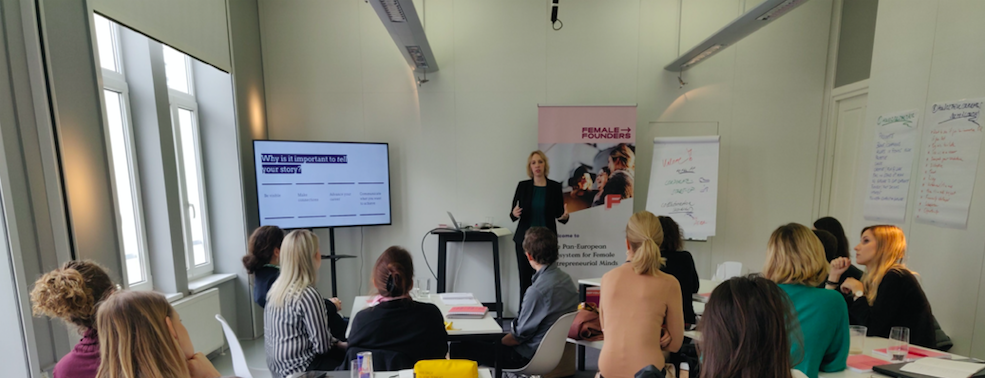Why storytelling makes all the difference in business
We recently caught up with branding and storytelling expert Rebecca Vogels and talked about the power in telling your personal and your brand’s stories. Rebecca led one of our most popular workshops for start-ups founders and participants from our female leadership program not long ago, where she shared compelling storytelling techniques used by Netflix, Google, Facebook, and former US president Barack Obama.
Vogels spent years working in New York City and Silicon Valley and noticed how the major companies all placed storytelling at the center of their businesses as well as how skillfully New Yorkers dropped their personal stories in ways that sparked curiosity with the listener.
“Storytelling in Silicon Valley can be summarised with four words, story first, product second” Vogels said.
The story is the strategic starting place for everything with these companies on every business level, what they tell themselves, their employees, and their customers as a brand.
The reason the story comes first is that when you know your story you know where you want to go with your brand.
A key moment for Vogels was when she realised that we could apply the same principles these companies use to tell our personal story both externally and internally.
How do you tell your personal story in an interesting way?
You need to feel passionate about the story you’re telling and have it be as true to yourself as it can be. A personal story that resonates with people is a story that other people can identify with as well as having other people identify with the roles that go along with that story.
We are currently living in an attention economy and we tell stories because we want to connect with other people. We want the one-to-one or one-to-many connections that stories can have and share a perspective that is a little outside of the other person.
You used the Obama storytelling approach in one of your workshops, what is that?
The technique was used by Obama while giving campaign speeches across the United States. It’s part of the public narrative framework and was originally developed Marshall Ganz, the architect for Obama’s field campaign.
It consists of the “story of self”, the “story of us” and the “story of now”. The “story of self” answers the question, why you? And should be a personal narrative. Compelling personal narratives are about decisions and the values that have led to those decisions. In Obama’s case it was the boy who grew up with a single mother and did not come from a privileged background.
The “story of us” is how that personal story related to many other Americans and how he managed to create rapport and build empathy with them which resonated on a broader level. The “story of now” involved a hopeful action for a pressing future and answered the questions, why now? Why is this relevant and why should the audience care?
From a brand perspective, this is how one founder participating in the recent workshop used it very effectively.
The start-up runs a traveling agency targeting busy families. The “story of self” was the founder having expertise knowledge into what busy families are looking for when booking holidays as she’s a mother herself. The “story of us” was the bigger context of how lots of families are struggling to find family-friendly holidays. The “story of now” was how these families were living more and more hectic lives and in need of a holiday and that’s how the services offered by the start-up could help.
This type of two-minute brand pitch clearly explains why people should care and given how busy everyone’s lives are it’s key to tell personal and brand stories that explain how they are relevant at this time.
Another effective technique to tell your brand’s story is the three-room principle. It’s a positioning framework where you connect value and product. First, you look at the context in which you are operating. What is the big picture? Second, you look at the value you’re providing. Finally, you focus on your product and explain how it works.
This model of super short storytelling is used by many of the major companies.
Dropbox would be an example of this – their context is, we’re operating in a busy world and it’s important to have a workflow that works for you. The value is that with our solution you can work from everywhere and the product works by synchronising everything. Again, they are placing the story first and the product second.
Tell us about the Netflix effect and how we can use it when telling our stories
Netflix and all of the other streaming services have a huge influence on storytelling and how brands tell their stories.
We’re no longer so interested in what’s going but instead, we care about why people do what they do. In many hit-shows, the protagonists end up doing quite horrible things but when we know their backstory we identify and empathize with them anyways. Building complex characters and complex plots are what series on Netflix do so brilliantly.
The dramatic structure has changed quite a lot, there used to be a clear plotline start, middle, and end to an episode. Now, there is much more of an emotional rollercoaster in one episode, and there is a new dramatic plot that starts in the middle of an episode. There are often small endings in the middle of the episode and that is probably when you should turn it off unless you want to continue binge watching.
In the beginning, there is always a very strong hook and that’s what we can use when we tell our story as well. One thing you can do is to start with a question of some sort when you tell your story to a person you meet for the first time.
“Did I tell you how a TV show got me into Harvard?” It’s all about catching the interest and making the other person wanting to ask a question back to you. With everything you tell you to want to make sure the audience wants to hear more.
Why does personal storytelling matter?
The way we tell ourselves stories is how we make sense of the world and our personal story is a big part of our identity, what we usually do is tell ourselves a story that we follow and then navigate life through that specific story that’s why the stories we tell ourselves are so powerful!
Rebecca Vogels is the founder and CEO of the brand and story-agency All of the Above. She is a Forbes contributor and was named top 50 most powerful women in tech by California Diversity Council. Her next workshops on personal branding take place March 28 and May 9.

